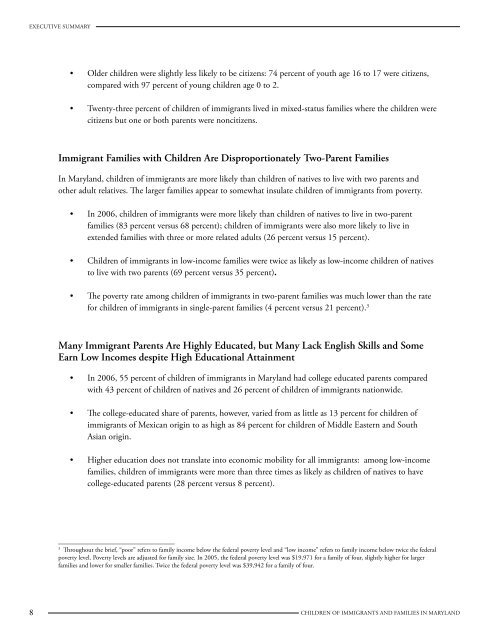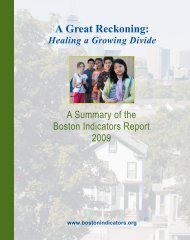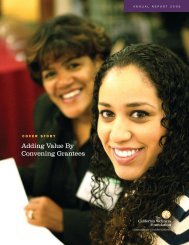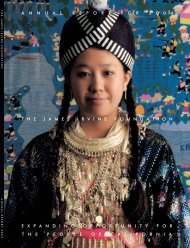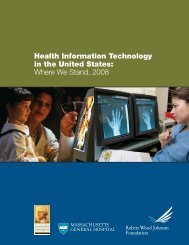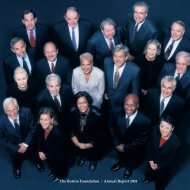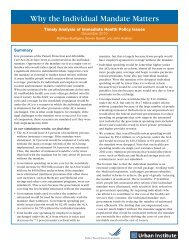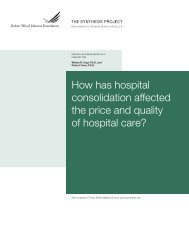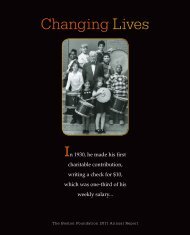The Integration of Immigrants and Their Families in Maryland: A ...
The Integration of Immigrants and Their Families in Maryland: A ...
The Integration of Immigrants and Their Families in Maryland: A ...
Create successful ePaper yourself
Turn your PDF publications into a flip-book with our unique Google optimized e-Paper software.
executive summary• Older children were slightly less likely to be citizens: 74 percent <strong>of</strong> youth age 16 to 17 were citizens,compared with 97 percent <strong>of</strong> young children age 0 to 2.• Twenty-three percent <strong>of</strong> children <strong>of</strong> immigrants lived <strong>in</strong> mixed-status families where the children werecitizens but one or both parents were noncitizens.Immigrant <strong>Families</strong> with Children Are Disproportionately Two-Parent <strong>Families</strong>In Maryl<strong>and</strong>, children <strong>of</strong> immigrants are more likely than children <strong>of</strong> natives to live with two parents <strong>and</strong>other adult relatives. <strong>The</strong> larger families appear to somewhat <strong>in</strong>sulate children <strong>of</strong> immigrants from poverty.• In 2006, children <strong>of</strong> immigrants were more likely than children <strong>of</strong> natives to live <strong>in</strong> two-parentfamilies (83 percent versus 68 percent); children <strong>of</strong> immigrants were also more likely to live <strong>in</strong>extended families with three or more related adults (26 percent versus 15 percent).• Children <strong>of</strong> immigrants <strong>in</strong> low-<strong>in</strong>come families were twice as likely as low-<strong>in</strong>come children <strong>of</strong> nativesto live with two parents (69 percent versus 35 percent).• <strong>The</strong> poverty rate among children <strong>of</strong> immigrants <strong>in</strong> two-parent families was much lower than the ratefor children <strong>of</strong> immigrants <strong>in</strong> s<strong>in</strong>gle-parent families (4 percent versus 21 percent). 3Many Immigrant Parents Are Highly Educated, but Many Lack English Skills <strong>and</strong> SomeEarn Low Incomes despite High Educational Atta<strong>in</strong>ment• In 2006, 55 percent <strong>of</strong> children <strong>of</strong> immigrants <strong>in</strong> Maryl<strong>and</strong> had college educated parents comparedwith 43 percent <strong>of</strong> children <strong>of</strong> natives <strong>and</strong> 26 percent <strong>of</strong> children <strong>of</strong> immigrants nationwide.• <strong>The</strong> college-educated share <strong>of</strong> parents, however, varied from as little as 13 percent for children <strong>of</strong>immigrants <strong>of</strong> Mexican orig<strong>in</strong> to as high as 84 percent for children <strong>of</strong> Middle Eastern <strong>and</strong> SouthAsian orig<strong>in</strong>.• Higher education does not translate <strong>in</strong>to economic mobility for all immigrants: among low-<strong>in</strong>comefamilies, children <strong>of</strong> immigrants were more than three times as likely as children <strong>of</strong> natives to havecollege-educated parents (28 percent versus 8 percent).3Throughout the brief, “poor” refers to family <strong>in</strong>come below the federal poverty level <strong>and</strong> “low <strong>in</strong>come” refers to family <strong>in</strong>come below twice the federalpoverty level. Poverty levels are adjusted for family size. In 2005, the federal poverty level was $19,971 for a family <strong>of</strong> four, slightly higher for largerfamilies <strong>and</strong> lower for smaller families. Twice the federal poverty level was $39,942 for a family <strong>of</strong> four.8Children <strong>of</strong> <strong>Immigrants</strong> <strong>and</strong> <strong>Families</strong> <strong>in</strong> Maryl<strong>and</strong>


